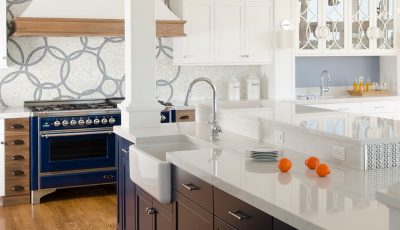Interesting Facts About Silestone Worktops
Choosing the right countertop material for the kitchen can always be a time-consuming task. When compared to other alternatives like marble or granite, Silestone offers numerous benefits that not only make the kitchen worktop an aesthetically pleasing space but a more functional one as well.
Commonly referred to as quartz, Silestone is engineered from quartz crystals. Used in a wide variety of indoor applications like kitchen countertops, bathroom wall cladding, shower trays, floors and sinks, Silestone offers a slew of benefits while allowing homeowners to obtain a high-end look for their kitchens sans the maintenance involved. Accordingly, here are some interesting facts about Silestone Calacatta worktops you may want to know about before purchasing the same for your kitchen.
Fact 1: Silestone Is Not Made Up Only Of Quartz
Silestone is manufactured from naturally occurring quartz crystals and other raw ingredients like colouring agents, polyester resins and polymers, etc. The polyester resin plays an important role in holding the quartz crystals together to create a polished Silestone surface. The end product looks like marble and granite but is shinier than both owing to the sparkling quartz crystals embedded in it.

Fact 2: Its Many Benefits Make It Better Than Granite Or Marble Countertops
Silestone Calacatta worktops come with a lot of benefits that make them superior to other kitchen countertop materials like marble or granite. Some of these benefits include:
Superior Scratch Resistance
Not only is Silestone scratch resistant but scorch resistant as well. The durability of quartz comes as a blessing in disguise for Silestone, which is highly resistant to scratches and chipping while its flexibility renders a soft look to the kitchen. This makes Silestone a great choice for busy kitchens.
Higher Resistance to Bacterial Infections
When compared to marble or granite, which are porous to an extent, Silestone is non-porous, meaning there is no way for stains or bacteria to permeate the worktop surface. Added to this is the fact that the Silestone Calacatta worktops are fitted with an additional antimicrobial protective layer during the manufacturing process, making these worktops highly resistant to stains and bacterial infections.
Photo by PREMIER GRANITE AND MARBLE
Easy Maintenance
Silestone worktops are easy to maintain, offering the same look and feel of marble or granite worktops sans the special maintenance required for the latter choices. The worktop surface can be cleaned with a mild detergent and a soft cloth. Periodic cleaning can help keep the worktop clean and retain its shine for longer periods.
Photo by Silestone by Cosentino
Fact 3: It Comes With Some Disadvantages Too
Although superior to marble or granite worktops in form and functionality, Silestone Calacatta worktops come with some disadvantages that are worth taking a look at as well.
Expense
Silestone is expensive when compared to other countertop materials. The high-cost factor is attributed to the number of natural materials that go into making the Silestone surface and is the major reason why Silestone worktops are the most expensive in the market.
Photo by Ossolinski Architects, PLLC
Appearance Issues
Silestone is obtained in a wide variety of patterns and colours, allowing homeowners to choose a colour or pattern that best suits the existing kitchen décor. However, that said and done, it does offer limited colour options when compared to marble or granite, which offer a lot more colour and design options to choose from. The generic nature of Silestone also limits its colour scheme to a few colours, which makes customization a problem for some kitchens.
Photo by Silestone by Cosentino
Another problem with Silestone Calacatta worktops is the appearance of seams on the surface. While they may not be noticeable on smaller surfaces, they tend to stick out like a sore thumb on larger Silestone worktops, thus affecting the overall appearance of the worktop surface.
Less Tolerance to Heat
While it may be scorch resistant, Silestone is less tolerant to high temperatures. The surface may crack under the extreme heat of a utensil placed directly on it after being heated. This forces homeowners to use trivets or other protective materials to avoid risking damage to the countertop material.
Photo by Remodel Works Bath & Kitchen
Limited Tolerance for Chemicals
Silestone Calacatta worktops are sensitive to harsh chemicals, which contain bleach or ammonia. Such chemicals can cause damage to the countertop surface and rob it of its shine. In case of accidental spills involving these chemicals, it is considered best to neutralize their effect immediately by washing them off with water and wiping the countertop surface with a soft cloth.
Restricted Indoor Use
Silestone worktops are made of up to 6% of colour pigments and resins. While quartz is UV resistant, these polymers and resins are unstable under direct sunlight, meaning they may cause the worktop surface to appear dull with prolonged exposure to the UV rays of the sun.

















